A New Methodology to Estimate the Early-Age Compressive Strength of Concrete before Demolding
Abstract
:1. Introduction
2. Testing Method and Materials
2.1. Pin Penetration Testing Device
2.2. Technique of Measuring Strength before Demolding
2.3. Pin Penetration Test at Construction Site and Mock-Up Mold
2.4. Concrete Used in the Experiment
2.5. Compressive Strength Test
3. Results and Discussion
3.1. Temperature Difference between Site Concrete and Specimens
3.2. Accumulated Temperature and Strength Delaying Time
3.3. Relationship between Compressive Strength and Penetration Depth
3.4. Surface Condition of Concrete after Demolding
4. Conclusions
- It is confirmed that the pin penetration test method is suitable to measure the early-age compressive strength before demolding at actual construction site.
- The relationship between pin penetration depth and compressive strength of concrete was determined at actual construction site using the mock-up specimens. The obtained results were different from the existing curves obtained in laboratory experiments.
- The strength development of specimens was significantly delayed compared to mock-up specimens even when specimens were cured at same ambient air temperatures. Therefore, it confirms that the pin penetration test method is important to determine early-age compressive strength before demolding at actual construction site.
- The relationship between pin penetration depth and compressive strength gives higher correlation when using the acrylic pipes. However, the compressive strength range that can be estimated by the proposed method in this study was from 3 MPa to 15 MPa.
- It is confirmed that when the compressive strengths are greater than 5 MPa and 10 MPa, the penetration depths are smaller than 8.0 mm and 6.7 mm, respectively.
Author Contributions
Funding
Data Availability Statement
Acknowledgments
Conflicts of Interest
References
- Narantogtokh, B.; Nishiwaki, T.; Pushpalal, D.; Taniguchi, M. Influence of pre-curing period at sub-zero temperature (−20 °C) on the compressive strength of concrete. Cem. Sci. Concr. Technol. 2022, 76, 379–385. [Google Scholar] [CrossRef]
- Japanese Architectural Standard Specification JASS 5 Reinforced Concrete Work; Architectural Institute of Japan: Tokyo, Japan, 2018. (In Japanese)
- Recommendation for Practice of Cold Weather Concreting; Architectural Institute of Japan: Tokyo, Japan, 2010. (In Japanese)
- RILEM. RILEM Recommendations for Concreting in Cold Weather; VTT Technical Research Centre of Finland: Espoo, Finland, 1988. [Google Scholar]
- Revilla-Cuesta, V.; Ortega-Lopez, V.; Faleschini, F.; Espinosa, A.B.; Serrano-Lopez, R. Hammer rebound index as an overall-mechanical-quality indicator of self-compacting concrete containing recycled concrete aggregate. Constr. Build. Mater. 2022, 347, 128549. [Google Scholar] [CrossRef]
- Szilágyi, K.; Borosnyói, A.; Zsigovics, I. Extensive statistical analysis of the variability of concrete rebound hardness based on a large database of 60 years experience. Constr. Build. Mater. 2014, 53, 333–347. [Google Scholar] [CrossRef]
- Kumavat, N.R.; Chandak, N.R.; Patil, I.T. Factors influencing the performance of rebound hammer used for non-destructive testing of concrete members: A review. Case Stud. Constr. Mater. 2021, 14, e00491. [Google Scholar] [CrossRef]
- Odimegwu, T.C.; Amrul Kaish, A.B.M.; Zakaria, I.; Abood, M.M.; Jamil, M.; Ngozi, K.O. Nondestructive determination of strength of concrete incorporating industrial wastes as partial replacement for fine aggregate. Sensors 2021, 21, 8256. [Google Scholar] [CrossRef] [PubMed]
- Mata, R.; Ruiz, R.O.; Nunez, E. Correlation between compressive strength of concrete and ultrasonic pulse velocity: A case of study and a new correlation method. Constr. Build. Mater. 2023, 369, 130569. [Google Scholar] [CrossRef]
- Bogas, J.A.; Gomes, M.G.; Gomes, A. Compressive strength evaluation of structural lightweight concrete by non-destructive ultrasonic pulse velocity method. Ultrasonics 2013, 53, 962–972. [Google Scholar] [CrossRef] [PubMed]
- Andrade, M.; Lopes, A.; Júnior, M.; Cristina, G. Ultrasonic testing on evaluation of concrete residual compressive strength: A review. Constr. Build. Mater. 2023, 373, 130887. [Google Scholar] [CrossRef]
- Moreira, R.; Gondim, L.; Haach, V.G. Monitoring of ultrasonic velocity in concrete specimens during compressive loading-unloading cycles. Constr. Build. Mater. 2021, 302, 124218. [Google Scholar] [CrossRef]
- Liang, M.T.; Wu, J. Theoretical elucidation on the empirical formulae for the ultrasonic testing method for concrete structures. Cem. Concr. Res. 2002, 32, 1763–1769. [Google Scholar] [CrossRef]
- Lencis, U.; Udris, A.; Korjakins, A. Frost influence on the ultrasonic pulse velocity in concrete at early phases of hydration process. Case Stud. Constr. Mater. 2021, 15, e00614. [Google Scholar] [CrossRef]
- Solis-Carcaňo, R.; Moreno, E.I. Evaluation of concrete made with crushed limestone aggregate based on ultrasonic pulse velocity. Constr. Build. Mater. 2008, 22, 1225–1231. [Google Scholar] [CrossRef]
- Ali-benyahia, K.; Kenai, S.; Ghrici, M.; Sbartaï, Z. Analysis of the accuracy of in-situ concrete characteristic compressive strength assessment in real structures using destructive and non-destructive testing methods. Constr. Build. Mater. 2023, 366, 130161. [Google Scholar] [CrossRef]
- Hobbs, B.; Kebir, M.T. Non-destructive testing techniques for the forensic engineering investigation of reinforced concrete buildings. Forensic. Sci. Intern. 2007, 167, 167–172. [Google Scholar] [CrossRef] [PubMed]
- Poorarbabi, A.; Ghasemi, M.; Moghaddam, M.A. Concrete compressive strength prediction using non-destructive tests through response surface methodology. Ain Shams Eng. J. 2020, 11, 939–949. [Google Scholar] [CrossRef]
- Helal, J.; Sofi, M.; Mendis, P. Non-destructive testing of concrete: A review of methods. Elect. J. Struc. Eng. 2015, 14, 97–105. [Google Scholar] [CrossRef]
- JIS A 1155; Method for Measuring the Degree of Rebound of Concrete. Japanese Standards Association: Tokyo, Japan, 2012. (In Japanese)
- ISO 1970-7; Testing of Concrete—Part 7: Non-Destructive Tests on Hardened Concrete. International Organization for Standardization: Geneva, Switzerland, 2004.
- Technical Committee on Concrete Strength Estimation; The Society of Materials Science Japan. Guideline for Compressive Strength Estimation of Concrete by Schmidt Hammer (Draft). Mater. Test. 1958, 7, 426–430. (In Japanese) [Google Scholar]
- El-Mir, A.; El-Zahab, S.; Sbartaï, Z.M.; Homsi, F.; Saliba, J.; El-Hassan, H. Machine learning prediction of concrete compressive strength using rebound hammer test. J. Build. Eng. 2023, 64, 105538. [Google Scholar] [CrossRef]
- Breysse, D.; Martínez-Fernández, J.L. Assessing concrete strength with rebound hammer: Review of key issues and ideas for more reliable conclusions. Mater. Struc. 2014, 47, 1589–1604. [Google Scholar] [CrossRef]
- Breysse, D. Nondestructive Evaluation of Concrete Strength: An Historical Review and a New Perspective by Combining NDT Methods. Const. Build. Mater. 2012, 33, 139–163. [Google Scholar] [CrossRef]
- Gunes, B.; Karatosun, S.; Gunes, O. Drilling resistance testing combined with SonReb methods for nondestructive estimation of concrete strength. Constr. Build. Mater. 2023, 362, 129700. [Google Scholar] [CrossRef]
- Al-sabah, S.; Sourav, S.N.A.; Mcnally, C. The post-installed screw pull-out test: Development of a method for assessing in-situ concrete compressive strength. J. Build. Eng. 2021, 33, 101658. [Google Scholar] [CrossRef]
- Maliha, M.; Nishiwaki, T.; Amin, A.F.M.S. A Screening Method for Very-Low-Strength Concrete. ACI Mater. J. 2022, 119. [Google Scholar] [CrossRef]
- Nguyen, M.H.; Nakarai, K.; Kubori, Y.; Nishio, S. Validation of simple nondestructive method for evaluation of cover concrete quality. Constr. Build. Mater. 2019, 201, 430–438. [Google Scholar] [CrossRef]
- Shinozaki, T.; Fujii, K.; Kemi, T.; Shirayama, K. Estimation of Concrete Strength in Structures by the BOSS Method. J. Advanc. Concr. Technol. 2004, 2, 175–185. [Google Scholar] [CrossRef]
- JIS A 1163; Method of Making and Testing for Compressive Strength BOSS Specimens. Japanese Standards Association: Tokyo, Japan, 2020. (In Japanese)
- Levent, S.H.; Suleyman, G.; Kamil, K.; Osman, S. A Nondestructive Testing Technique: Nail Penetration Test. ACI Struct. J. 2012, 109, 245–252. [Google Scholar] [CrossRef]
- Herrera-Mesena, C.; Salvadorb, R.P.; Cavalaroc, S.H.P.; Aguadoa, A. Effect of gypsum content in sprayed cementitious matrices: Early age hydration and mechanical properties. Cem. Concr. Comp. 2019, 95, 81–91. [Google Scholar] [CrossRef]
- Maliha, M.; Nishiwaki, T.; Fujiwara, T.; Minemura, T. In-Place Test Method with Penetration Resistance for Low-Strength Concrete. Proc. Jpn. Concr. Inst. 2020, 42, 1732–1737. [Google Scholar]
- Nishiwaki, T.; Takasugi, F.; Narantogtokh, B.; Hara, S.; Maliha, M. A method to estimate the early age compressive strength of concrete before demolding using a pin penetration device. J. Struct. Constr. Eng. 2022, 88, 18–26. (In Japanese) [Google Scholar] [CrossRef]
- Noguchi, T. Quality Control System in Curing Concrete Using Small Integrated Circuit for Monitoring Temperature and Attitude on Formworks. JACIC Res. Dev. Rep 2010, 2010. (In Japanese). Available online: https://www.jacic.or.jp/josei/pdf/2010-16.pdf (accessed on 4 July 2024).
- ASTM C1074-11; Standard Practice for Estimating Concrete Strength by the Maturity Method. ASTM International: West Conshohocken, PA, USA, 2011.
- Popovics, S. Strength and Related Properties of Concrete: A Quantitative Approach; John Wiley & Sons: Hoboken, NJ, USA, 1998; p. 12. [Google Scholar]
- Zhou, S.; Sun, Q.; Wu, X. Impact of D/t Ratio on Circular Concrete-Filled High-Strength Steel Tubular Stub Columns under Axial Compression. Thin-Walled Struct. 2018, 132, 461–474. [Google Scholar] [CrossRef]
- Chen, H.; Wu, L.; Jiang, H.; Liu, Y. Seismic Performance of Prefabricated Middle Frame Composed of Special-Shaped Columns with Built-in Lattice Concrete-Filled Circular Steel Pipes. Structures 2021, 34, 1443–1457. [Google Scholar] [CrossRef]
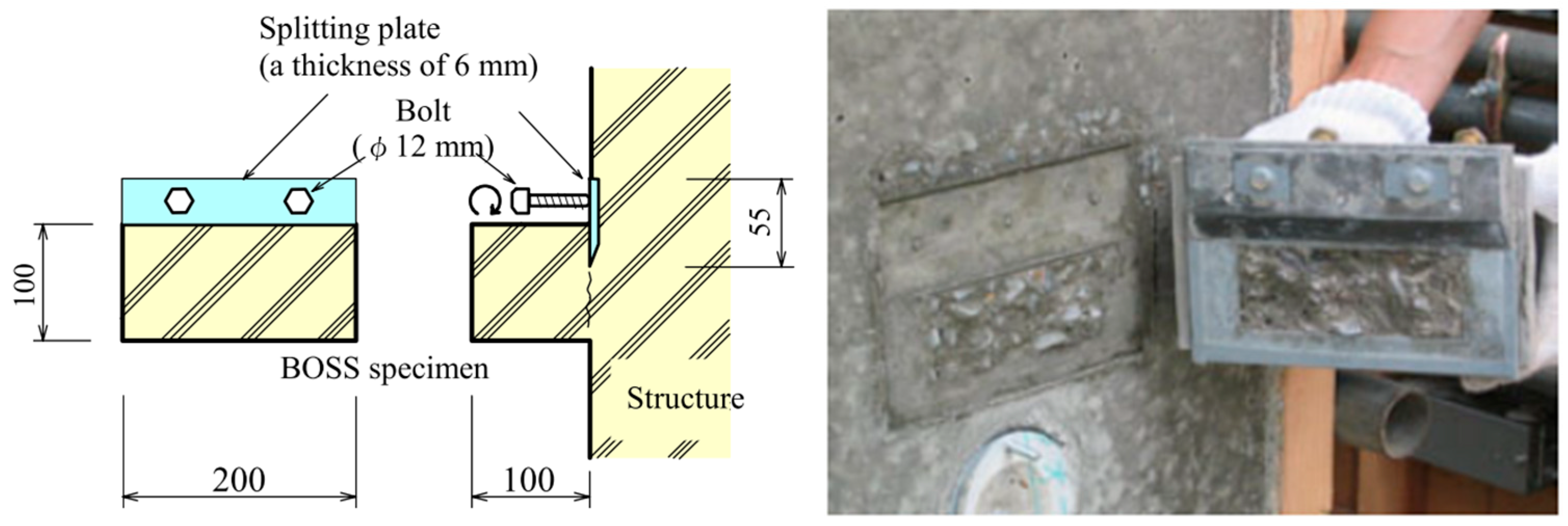

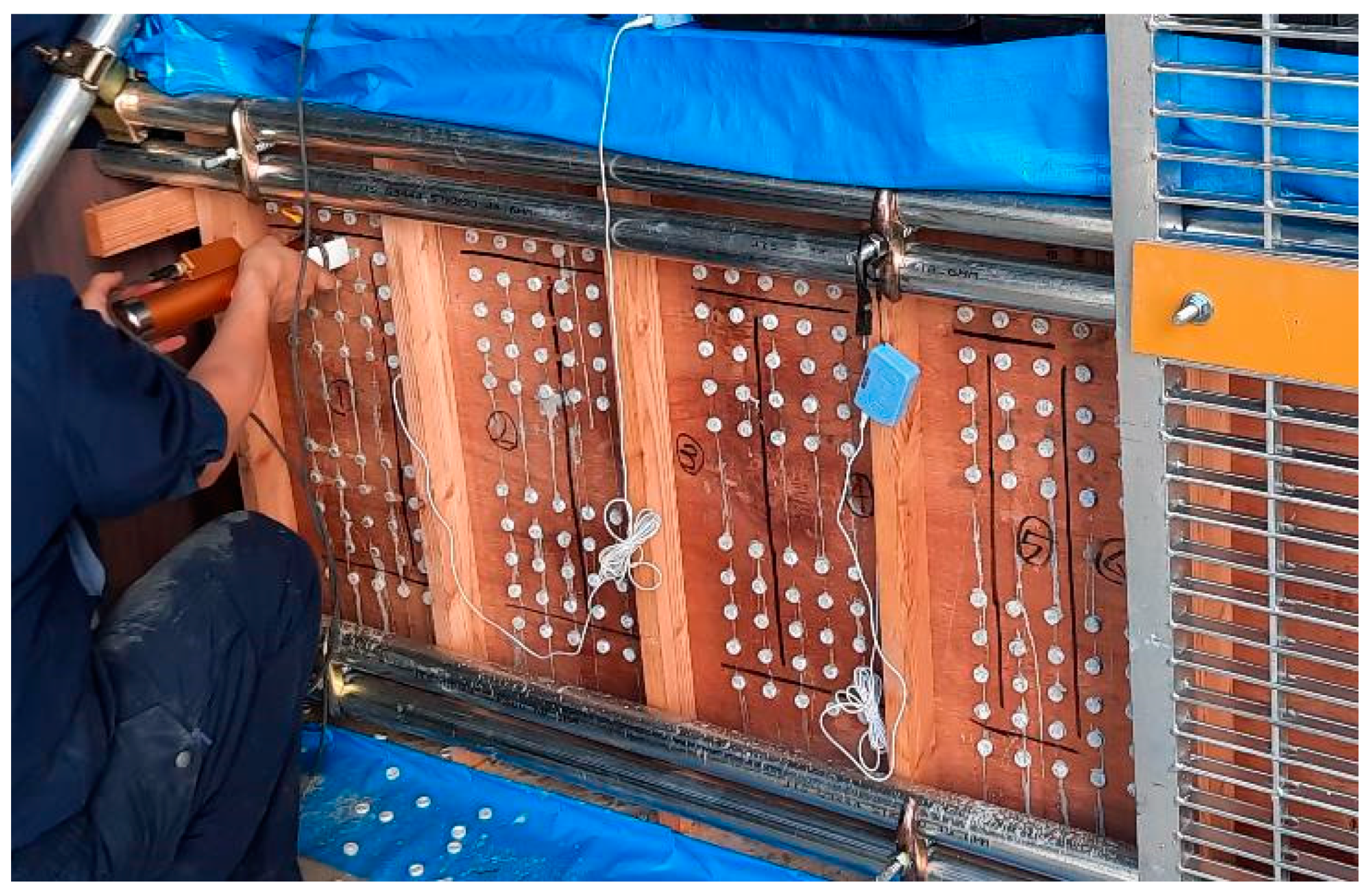
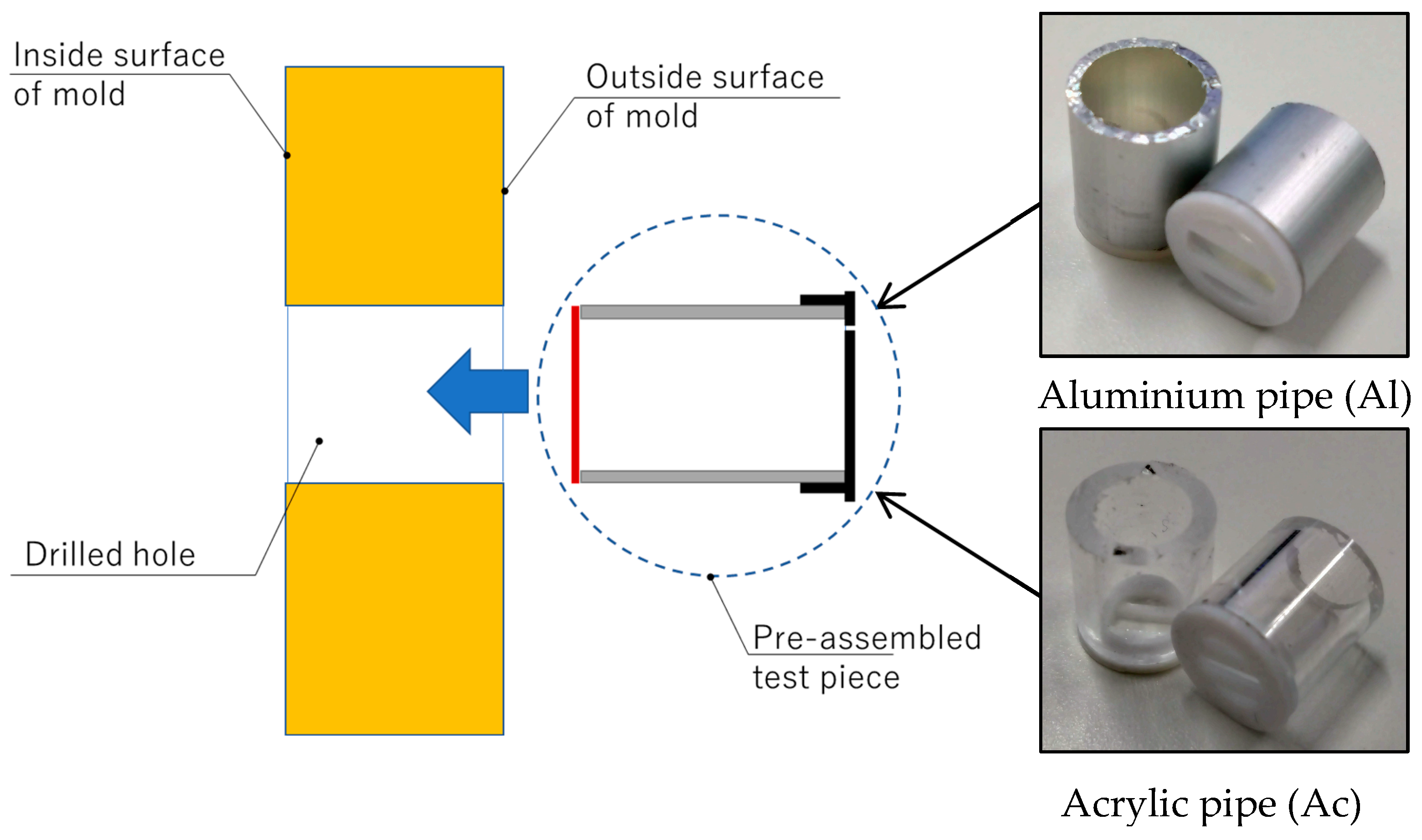
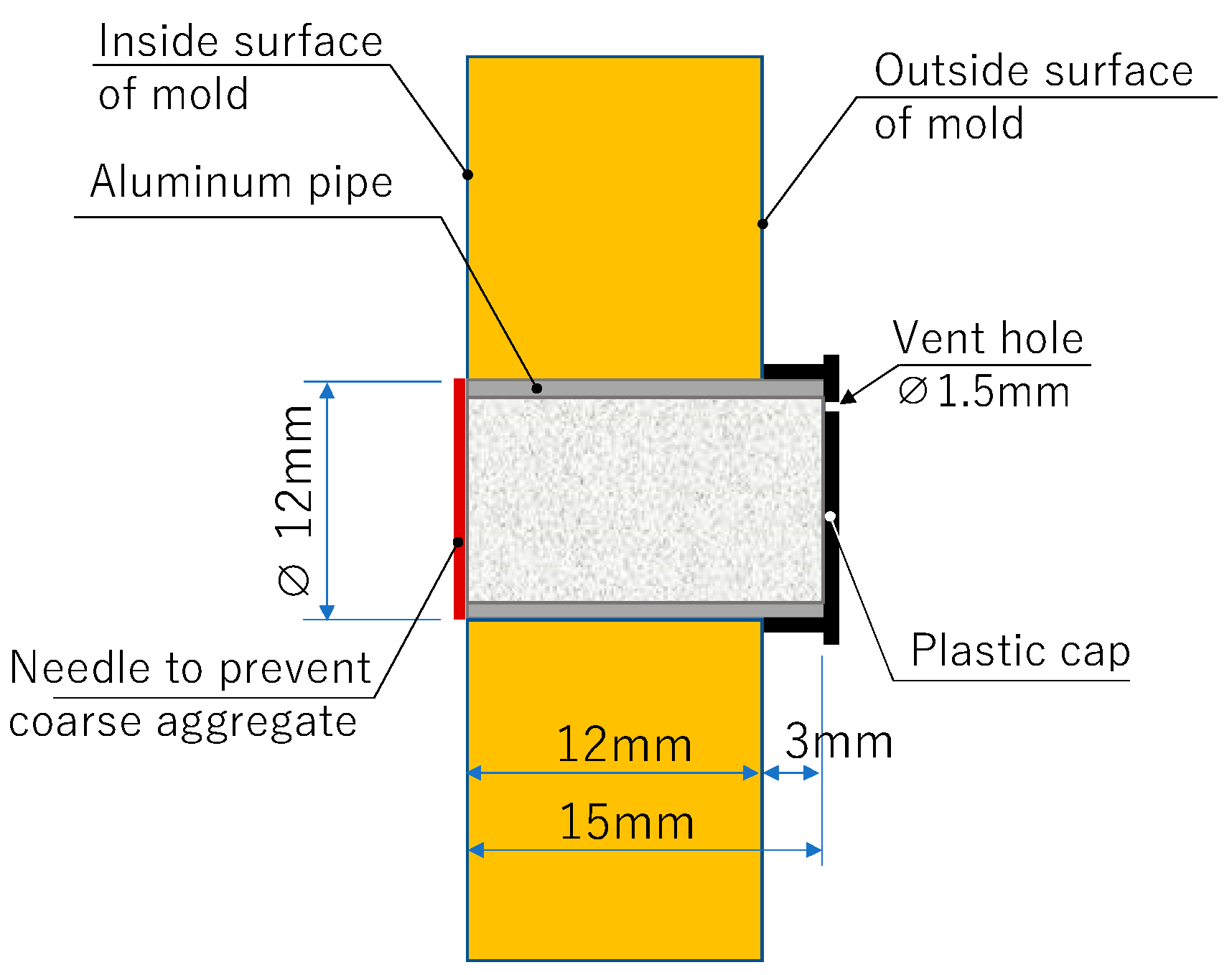
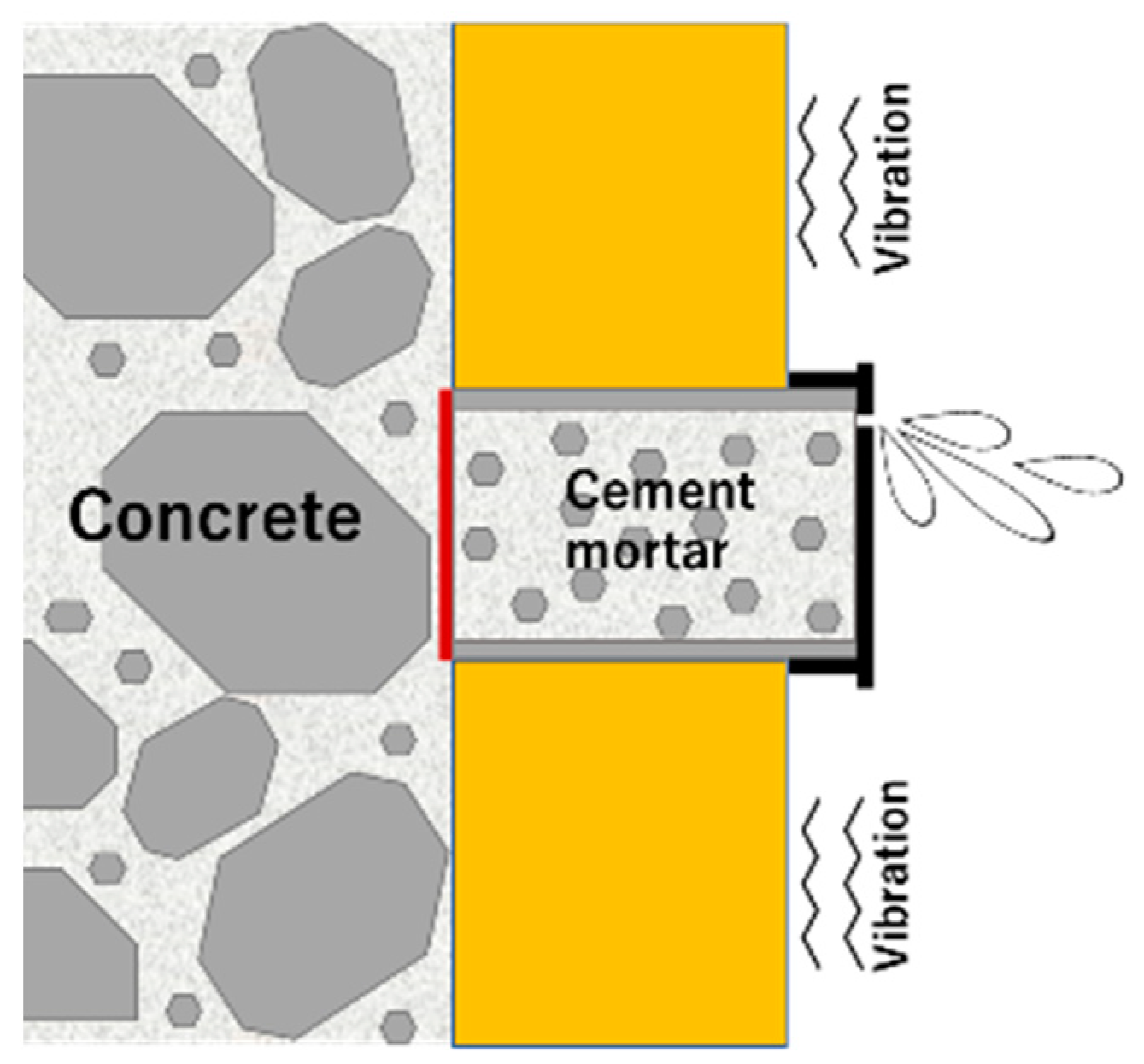
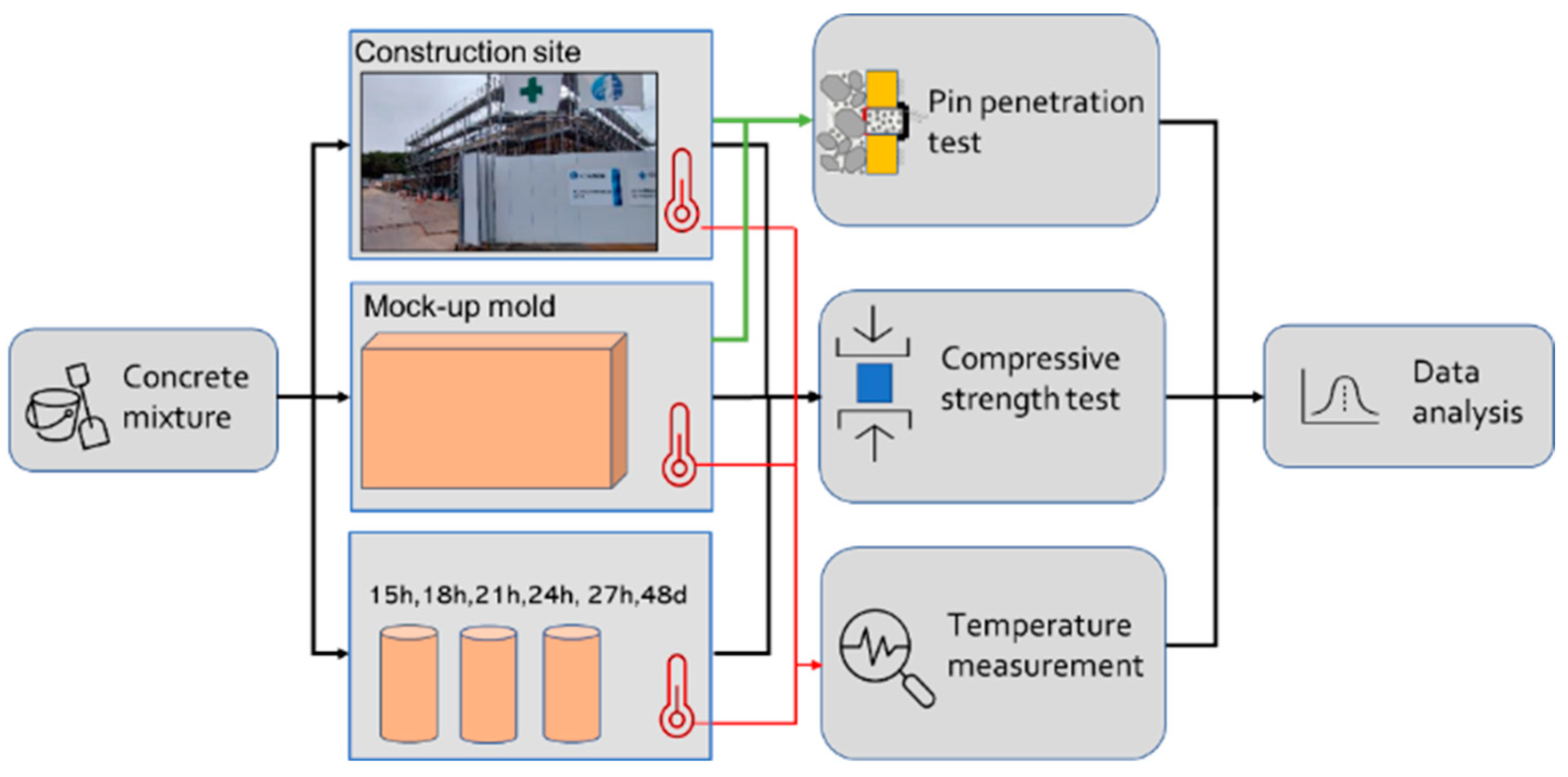


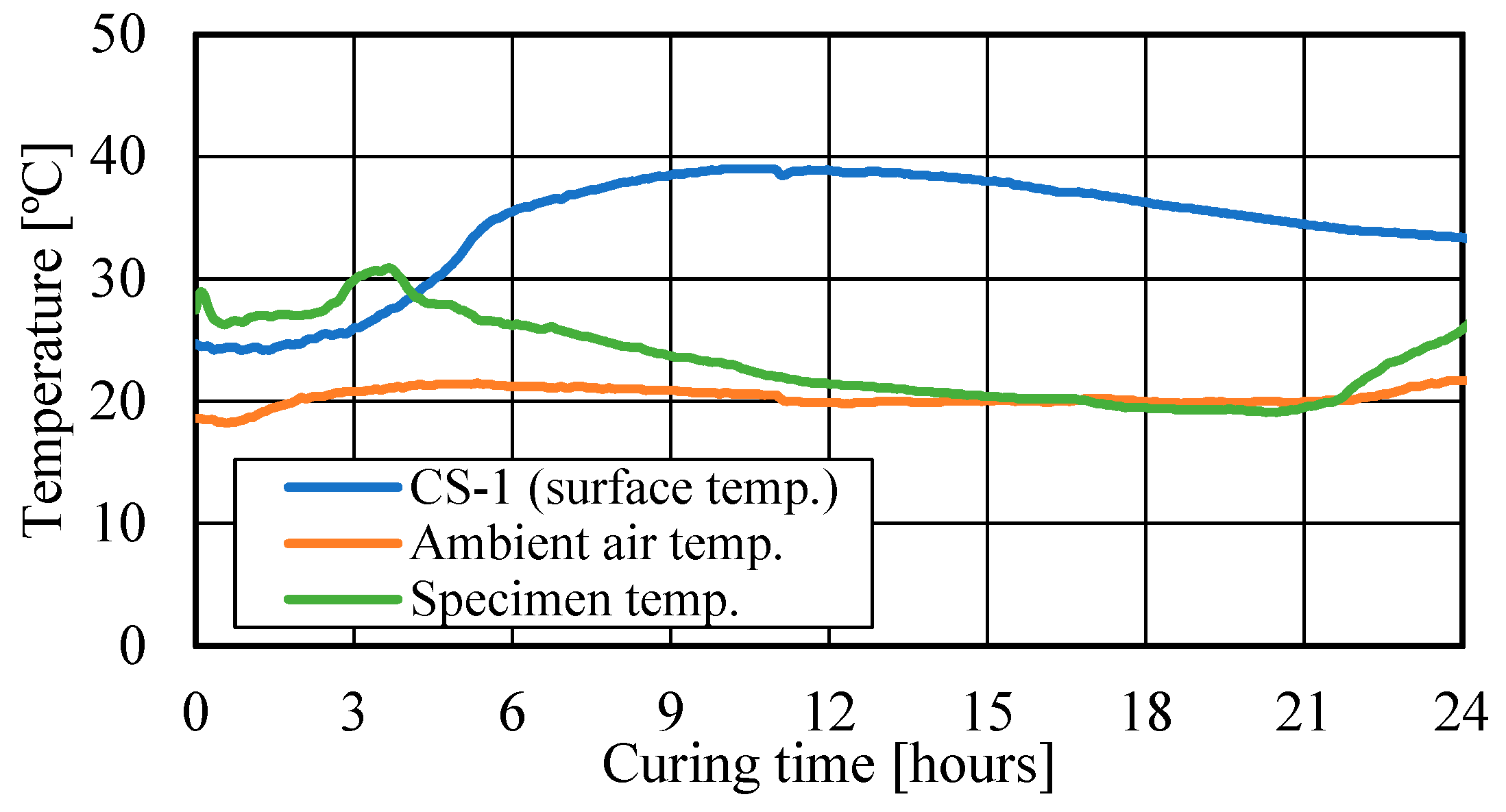

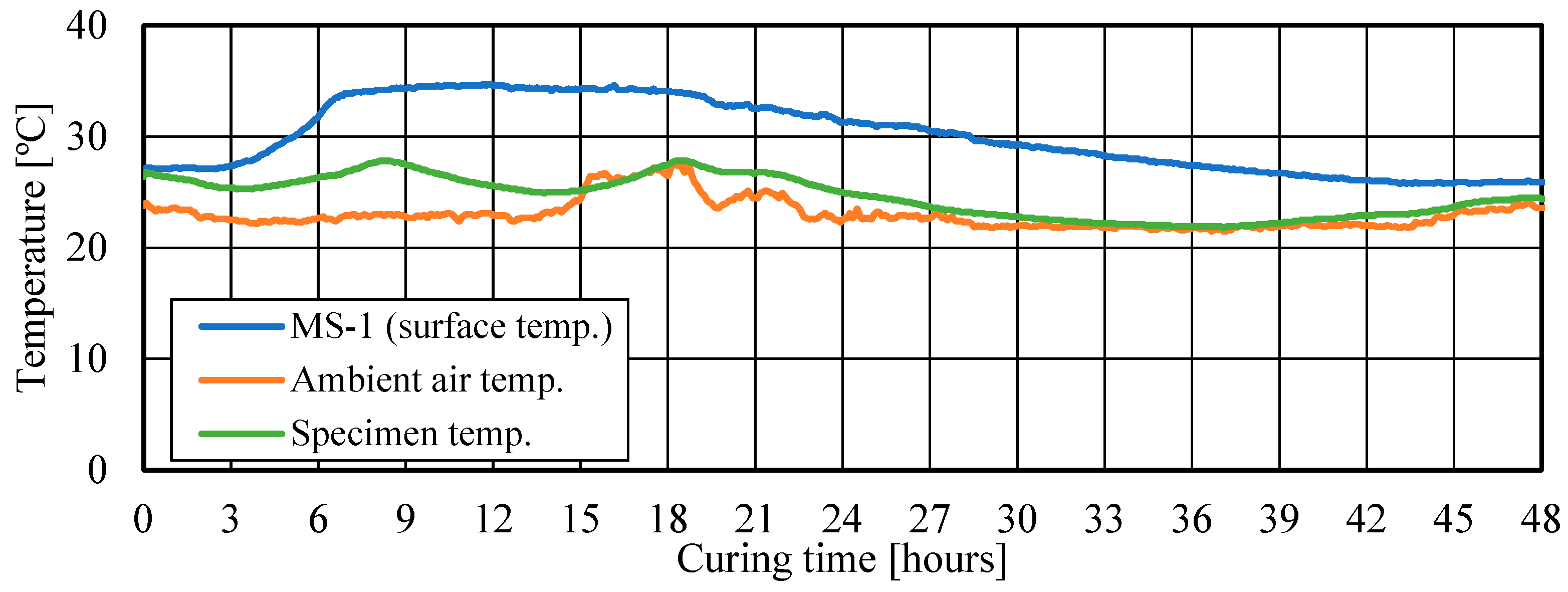
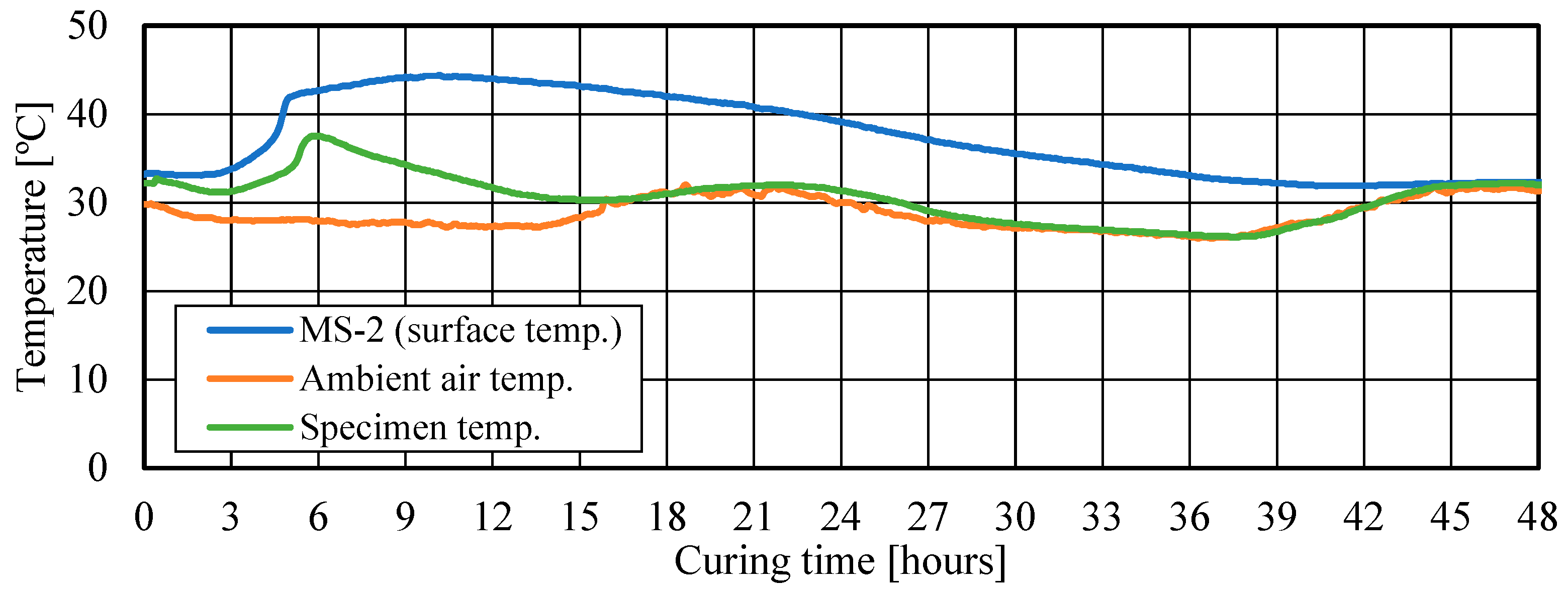
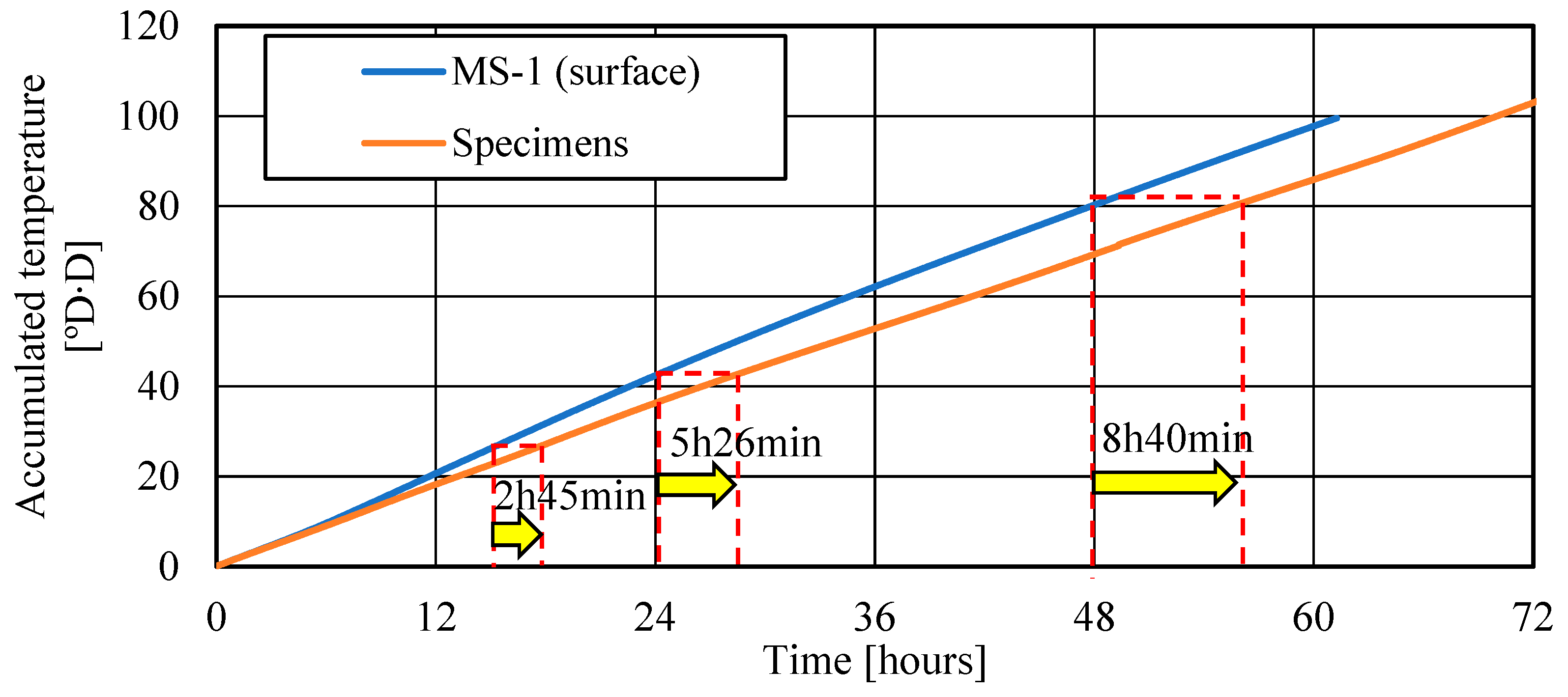
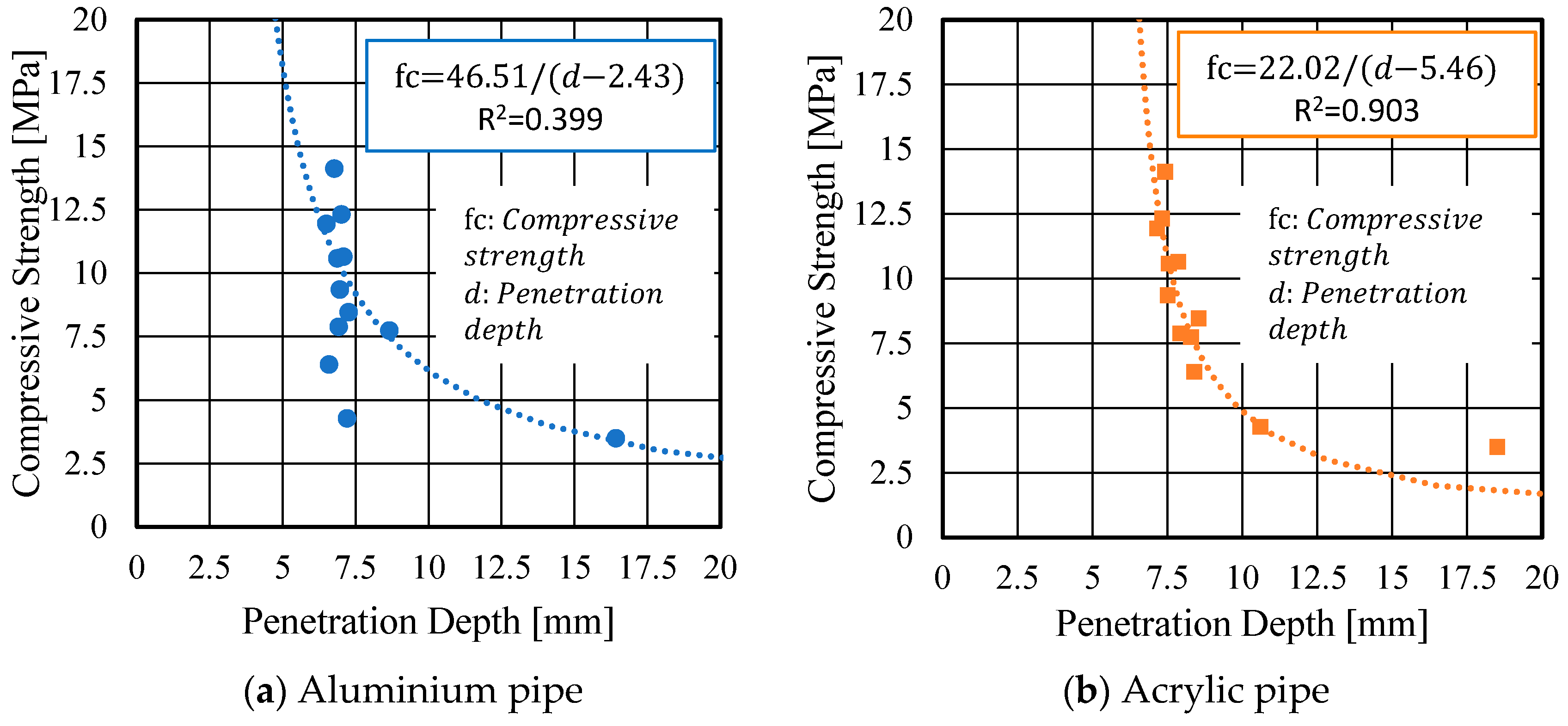


| Device Specification | Value Range |
|---|---|
| Measuring range | 0~35 mm |
| Measurement accuracy | 0.1 mm |
| Dimensions of device | 50 × 70 × 335 mm |
| Weight | ~2 kg |
| Energy | 6 J (Nm) |
| Determination | Curing Time | ||||||
|---|---|---|---|---|---|---|---|
| 15 h | 18 h | 21 h | 24 h | 27 h | 48 h | ||
| Mock-up mold | Al pipe | ○ | ○ | ○ | ○ | ○ | ○ |
| Ac pipe | ○ | ○ | ○ | ○ | ○ | ○ | |
| Construction site | Al pipe | ○ | ○ | ○ | ○ | ||
| Ac pipe | ○ | ○ | ○ | ○ | |||
| Series | Testing Condition | Nominal Strength [MPa] | Slump [cm] |
|---|---|---|---|
| CS-1 | Construction site (at ambient air temperature) | 36 | 21 |
| CS-2 | 36 | 21 | |
| MS-1 | Mock-up specimens (at ambient air temperature) | 24 | 18 |
| MS-2 | 30 | 18 |
| Series | W/C [%] | Cement | Water | Fine Aggregate * | Coarse Aggregate | Admixture |
|---|---|---|---|---|---|---|
| CS-1 | 41.0 | 427 | 175 | 598, 158 | 969 | 6.41 |
| CS-2 | 41.0 | 427 | 175 | 598, 158 | 969 | 6.41 |
| MS-1 | 54.0 | 324 | 175 | 659, 165 | 990 | 3.24 |
| MS-2 | 46.5 | 376 | 175 | 626, 157 | 990 | 3.76 |
| Compressive Strength [MPa] | Penetration Depth [mm] (Acrylic Pipe) |
|---|---|
| 5.0 | 8.02 (8.0) |
| 10.0 | 6.74 (6.7) |
Disclaimer/Publisher’s Note: The statements, opinions and data contained in all publications are solely those of the individual author(s) and contributor(s) and not of MDPI and/or the editor(s). MDPI and/or the editor(s) disclaim responsibility for any injury to people or property resulting from any ideas, methods, instructions or products referred to in the content. |
© 2024 by the authors. Licensee MDPI, Basel, Switzerland. This article is an open access article distributed under the terms and conditions of the Creative Commons Attribution (CC BY) license (https://creativecommons.org/licenses/by/4.0/).
Share and Cite
Narantogtokh, B.; Nishiwaki, T.; Takasugi, F.; Koyama, K.; Lehmann, T.; Jagiello, A.; Droin, F.; Ding, Y. A New Methodology to Estimate the Early-Age Compressive Strength of Concrete before Demolding. Buildings 2024, 14, 2099. https://doi.org/10.3390/buildings14072099
Narantogtokh B, Nishiwaki T, Takasugi F, Koyama K, Lehmann T, Jagiello A, Droin F, Ding Y. A New Methodology to Estimate the Early-Age Compressive Strength of Concrete before Demolding. Buildings. 2024; 14(7):2099. https://doi.org/10.3390/buildings14072099
Chicago/Turabian StyleNarantogtokh, Bayarjavkhlan, Tomoya Nishiwaki, Fumiya Takasugi, Ken Koyama, Timo Lehmann, Anna Jagiello, Félix Droin, and Yao Ding. 2024. "A New Methodology to Estimate the Early-Age Compressive Strength of Concrete before Demolding" Buildings 14, no. 7: 2099. https://doi.org/10.3390/buildings14072099
APA StyleNarantogtokh, B., Nishiwaki, T., Takasugi, F., Koyama, K., Lehmann, T., Jagiello, A., Droin, F., & Ding, Y. (2024). A New Methodology to Estimate the Early-Age Compressive Strength of Concrete before Demolding. Buildings, 14(7), 2099. https://doi.org/10.3390/buildings14072099








